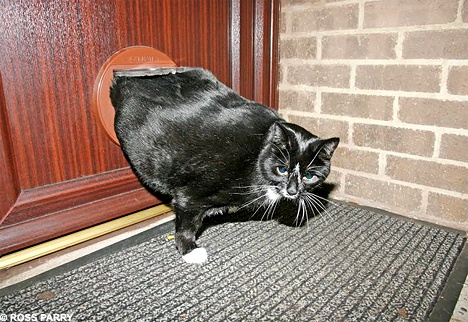Blog
Obesity Poses Huge Risks For Cats Too!
January 2, 2014

We’ve all read and seen the news reports on the obesity epidemic. Having an excess amount of body fat predisposes us to many illnesses including diabetes, high blood pressure, and liver disease (to name a few). Our quality of life is also affected, as obesity can be physically debilitating causing breathing issues, muscle and soft tissue injuries, and exhaustion. While we focus on these issues in ourselves, we all too easily overlook the fact that the same problem is occurring with our pets.
A survey conducted by the Association for Pet Obesity Prevention indicated that about 55% of cats are overweight and of those cats, only 15% of owners believed their cat to be overweight. Not only do we, as owners have the wrong idea of what a ‘healthy cat’ looks like, but we also do not understand that we are causing our cat’s obesity. Feeding high-calorie foods, overfeeding treats, and not practicing portion control are major factors that we can control that contribute to a cat’s weight gain. Lack of exercise also plays a role, as most cats are no longer predominantly outdoors hunting and exploring large areas of territory.
One of the biggest misconceptions that I commonly address with clients is that dry food is a preferable cat diet to canned. The exact opposite is true for cats. Cats are obligate carnivores, meaning they require a protein-rich diet with minimal carbohydrates. Cats are hunters! They don’t hunt corn or rice; they hunt for protein. If you look at the difference between canned and dry diets you will see that canned food is protein and moisture-based while dry foods have a grain as the first or second ingredient (grain-free dry foods are still carbohydrate-rich with sources like potatoes or sweet potatoes). Cats lack the ability to effectively convert carbohydrates to usable energy- it is mostly stored as fat! The same is true for most commercially available cat treats.
Obesity is a serious medical issue in both people and pets. As with people, overweight cats have a much higher likelihood of developing diabetes, and liver and skin diseases. Extra weight stresses tendons, ligaments, and joints, increasing the likelihood of injury and arthritis. Luckily, obesity and many of the illnesses associated with it are reversible. Using a diet that is designed for your cat’s unique nutritional needs and increase your cat’s activity are two ways that will help your cat lose or maintain a healthy weight.
We have many resources available to help you make changes that will improve both the health and quality of your cat’s life.



